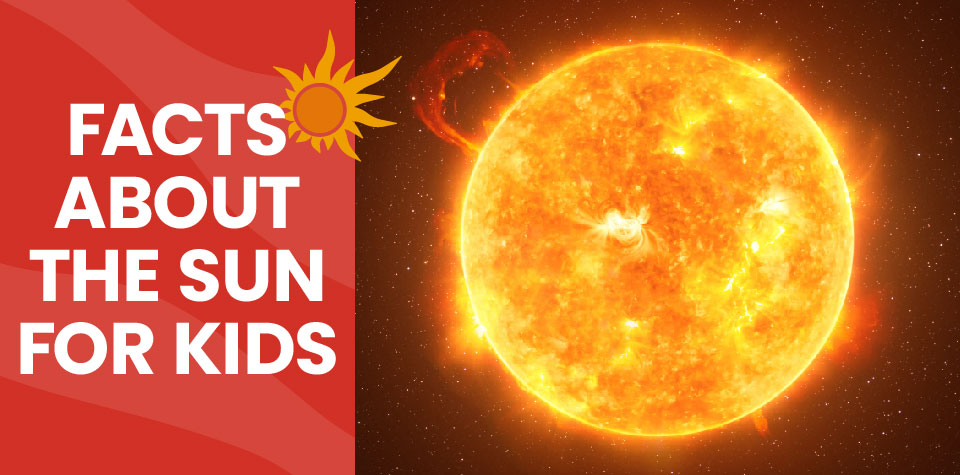
Send Your Kids’ Curiosity to Space with Facts about the Sun
When kids wake up to see sunlight streaming through their windows, they know it’s going to be a great day. To them, sunshine often means clear skies, warm weather, and lots of time playing outside. And while those things are top priority for most children, they’re just a few reasons why we love seeing the Sun.
What makes the Sun so special? In addition to its warmth and light, the Sun is essential for all life on Earth.
How much do you and your children know about the Sun? We can help your family learn more about the blazing star at the center of our solar system with these fascinating and fun facts about the Sun for kids.
The Sun’s Important Relationship with Earth
The Sun is a yellow dwarf star (or G-type main sequence star, the main stage in a star’s life cycle). It is located 93 million miles (about 150 million kilometers) from our planet. At such a great distance, you might think this ball of gas has little to do with us—but it’s actually one of the most important reasons animals, plants, and even bacteria can live on Earth.
What makes the Sun so vital? For one, its gravitational pull prevents the solar system from flying apart. The Sun accounts for over 99 percent of our solar system’s mass, and its pull keeps the planets—Mercury, Venus, Earth, Mars, Jupiter, Saturn, Uranus, and Neptune—and other celestial bodies like dwarf planets and asteroids orbiting around it.
The Sun also produces the energy that plants and animals need to survive. Without heat and light from the Sun, the water cycle wouldn’t transport water around the planet, plants couldn’t grow, and Earth would be far too cold for humans and other animals.

Getting Warmer
While the Sun is essential for life on Earth, no life could survive on this star (as far as scientists can tell). The Sun is far too hot!
Just how hot is the Sun? The star reaches temperatures around 10,000°F (5,500°C) on the surface and 27 million°F (15 million°C) at its core. Fun fact: The temperature on the surface of the Sun is hot enough to melt diamonds and bring them to a boil!
There are some cooler regions of the Sun called sunspots. Each one is about the size of a planet, and they form when the Sun’s magnetic field pushes through its surface and prevents heat from rising, resulting in darker, cooler areas. Still, sunspots are pretty hot—they’re usually around 6,700°F (3,700°C). That’s more than six times hotter than an industrial oven can get!
Where Does the Sun’s Energy Come From?
The Sun produces a lot of energy. In fact, it takes just 1.5 millionths of a second to release more energy than humans on Earth use in an entire year! But where’s all that energy coming from? The answer lies in two factors: the Sun’s size and temperature.
As we know, the Sun exerts a lot of gravity on the solar system. That gravitational force also puts a lot of pressure on the Sun itself. This immense pressure causes hydrogen atoms inside the Sun to collide with one another until they fuse into helium—a process known as nuclear fusion. That fusion releases energy that travels outward from the Sun’s core as heat and light.

Four More Awesome Facts about the Sun
People have been exploring the solar system for over 60 years (and have learned a lot of cool stuff in that time), but human civilizations have been fascinated by the Sun for millennia.
Ancient Egyptians worshiped the Sun in the fourteenth century BCE. In the 1500s, a Polish astronomer named Copernicus discovered the Sun was the center of our solar system. A century later, the Italian astronomer, philosopher, and mathematician Galileo figured out that Earth orbits the Sun.
We have a lot left to discover about the center of our solar system, and scientists are hard at work uncovering more of the Sun’s secrets thanks to technology that allows us to get closer to the star than ever before: about 5.3 million miles (8.5 million kilometers) away. While we wait for new discoveries, though, you and your kids can enjoy these fun facts about the Sun:
- The Sun is old. Just how old? The Sun has had over 4.6 billion birthdays! Despite its age, the Sun is currently in the main phase of its life cycle as a yellow dwarf. It has another 4.5–5.5 billion years left before it moves into its next phase and becomes a red giant.
- The Sun is enormous. It has a radius of about 435,000 miles (700,000 kilometers), making it 109 times wider than Earth. Because the Sun is a sphere, that big radius (the distance from its center to its outer edge) means it has a truly gargantuan volume: it would take about 1.3 million Earths to fill the Sun!
Despite its size, the Sun is far from the universe’s largest object. Many stars are larger than the Sun—including UY Scuti, the largest star in the known universe. UY Scuti is 5,219 light-years away from Earth, but we can still see it because it’s 1,700 times bigger than the Sun.
- The Sun isn’t solid. Although it may look like a solid sphere (like Earth and some of the other planets in our solar system), the Sun is made of superheated gas called plasma. The star has six layers: the core, radiative zone, convective zone, photosphere, chromosphere, and corona. Most of these layers are composed of hydrogen and helium gas, but traces of other elements are also present, including silicon, neon, and chromium.
- The Sun is moving. The Sun is the center of our solar system, but that doesn’t mean it’s fixed in one place in space. It orbits the center of the Milky Way galaxy at 225 kilometers per second—that’s about 503,000 miles (810,000 kilometers) per hour!

